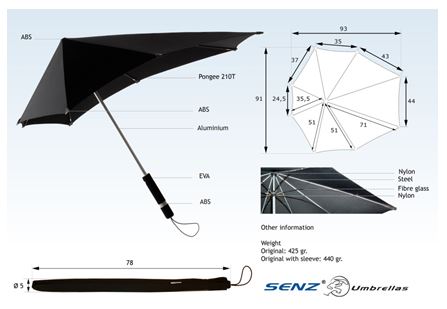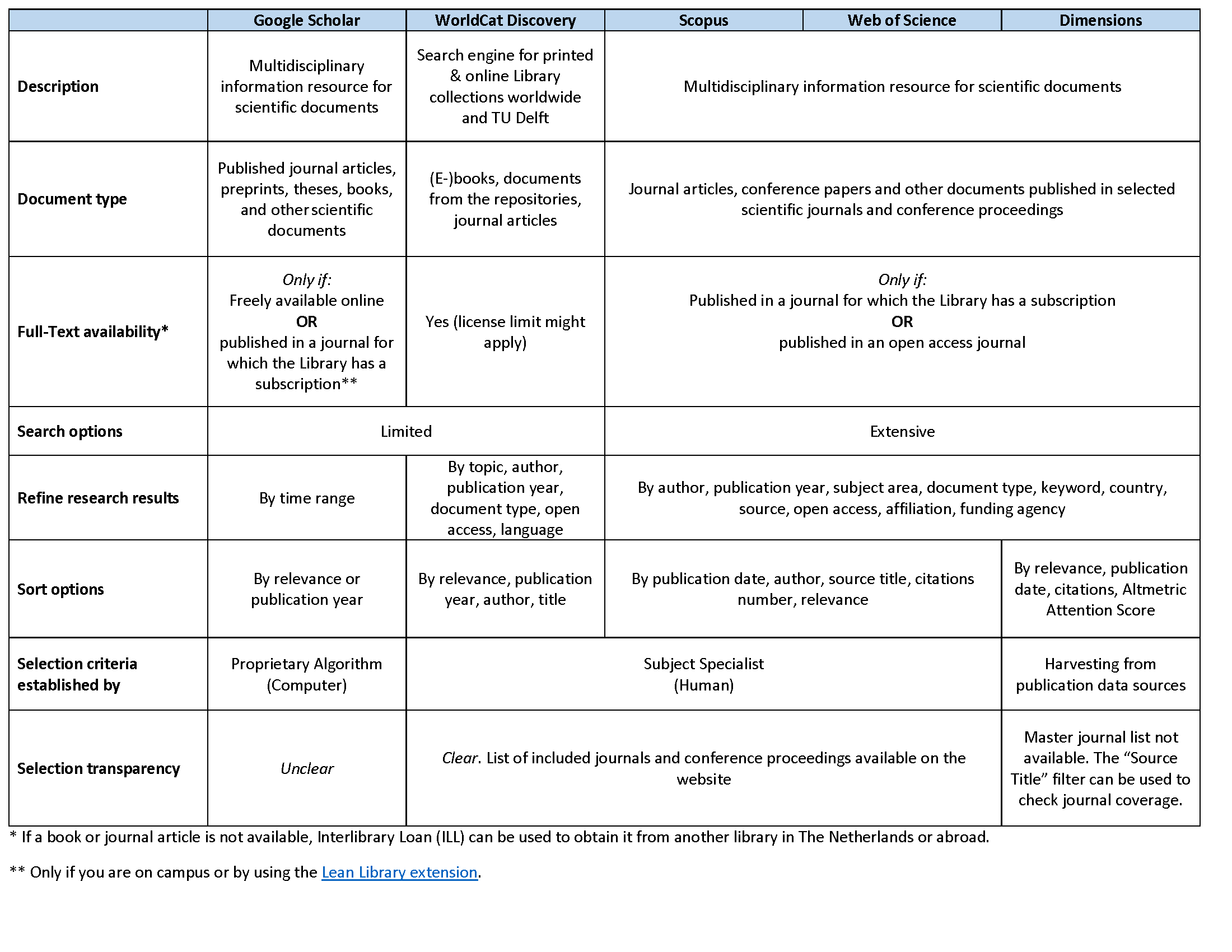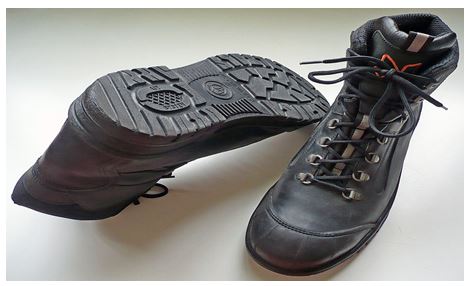Resources
On this page
Books
Journal articles and conference papers
Patents and standards
Other types of information
Relevant links
References
When you start working on a paper, for example, about the design and success of the Senz umbrella, you need different types of relevant information: background information about the development of umbrellas through the ages, an overview of the latest research into umbrellas complete with results in journal articles, the patent for the Senz umbrella, any standards that apply to umbrellas, as well as information about the marketing strategy used. For all these types of information, you need different documents, which you can find in different resources.
In this module we made a selection of the most common databases, for an overview of all databases you have access to via TU Delft Library, go to A-Z list.
For the most recommended sources by your faculty discipline go to Sources by faculty discipline and choose your faculty and faculty discipline.
Books
Background information about the development of umbrellas through the ages can be found in books. You can use the library’s search engine at the top of every TU Delft Library webpage to search for books, both printed and digital, with background or introductory information. You will find a description of each book, including where you can find it.
For example:
Farrell, J. (1985). Umbrellas and parasols. Batsford. This book is held in the closed stacks of the TU Delft Library.
Collect printed books yourself from the open shelves/book gallery. If the location is “closed stacks”, you need to make a request.
E-books
Most new books in the Library collection are e-books. You can access them online, whenever you need them. E-books offer full text searching as well as the option to add and save your own notes and bookmarks. Note: e-books are only available on campus or through a Virtual Private Network (VPN) connection!
Watch the clip below about using the library’s search engine and retrieving (e-) books.
On the timeline, you can jump to the different chapters.
-
Proquest Ebook Central This provider buys books from different publishers.
Access rules change all the time and sometimes books are removed from the platform.O'Reilly Safari In the library collection for a limit period of time;
unlimited access.Springerlink Perpetual access if purchased directly from the publisher. Wiley Online Library Perpetual access if purchased directly from the publisher. Elsevier Perpetual access if purchased directly from the publisher. Taylor & Francis (incl. CRC titles) Perpetual access if purchased directly from the publisher. Next to the providers above WorldCat Discovery also contains e-books from Cambridge University Press, De Gruyter, EBSCO, JSTOR, SAGE knowledge and World Scientific.
Most ebooks are ordered following purchase suggestions or for the Education Collection.
Journal articles and conference papers
You can find an overview of the latest research into umbrellas, complete with research results, in journal articles or conference papers.
Journal articles
If you are looking for the article “Fokkinga, S. & Desmet, P. (2014). Reversal Theory from a Design Perspective. Journal of Motivation, Emotion, and Personality, 2(2), 12-26”, check if the library has a subscription on the Journal of Motivation, Emotion, and Personality in the A-Z list of journal titles. The article is a scientific or scholarly article in which authors disseminate research results among fellow scientists. Therefore you can also check if the article is available through Google Scholar. Google Scholar is a scientific article database where you can click through to the full text of a journal article.
In addition to scientific or scholarly journals, there is another category of journals, namely trade journals or professional journals.
Trade journals or professional journals are meant to share technical developments with colleagues in the field.
In this table more differences between trade journals and scholarly journals are listed.
| Trade journal | Scholarly journal |
|---|---|
|
|
Article databases
If you are looking for the (latest) research data, published in a journal article or a conference paper, but you do not know in which journal or proceedings it may be published, you can use an article database, such as Scopus or Google Scholar. In an article database, you can search for articles about a particular topic. If you do know the author of an article, you can do a search on the author’s name.
There are two main groups of article databases: multidisciplinary and subject-specific databases, most databases are only available on TU Delft campus or via a VPN connection.
| Multidisciplinary databases | Subject-specific databases |
|---|---|
| cover a wide range of subject areas | cover a specific subject area |
| produce more results, but they will not necessarily all be relevant to your topic | produce fewer but more relevant results |
| often offer enhanced search tools | often offer enhanced search tools |
Watch the clip below about Scopus.
On the timeline, you can jump to the different chapters.
If you need more information on Scopus, visit the Scopus Tutorials on the Scopus website.
Differences between Google Scholar, Worldcat Discovery, Scopus, Web of Science & Dimensions
Patents and standards
You can find very specific technical information, such as the patent (or patent application) for the Senz umbrella or any standards that apply to umbrellas, in dedicated patent or standards databases.
Patents
A patent is a form of intellectual property. It grants an exclusive right (for a specific time period and geographic region) to produce and sell a technical solution to a problem. The documents describing a patent include very specific technical information, explaining exactly what is new about the invention. Often, reference is made to other patents, in order to identify the differences.
You can find patents in patent databases:
Espacenet | + bibliographic coverage + full-text coverage (for these country codes covering more than 80 countries) + filter queries on specific legal texts + well-documented and up-to-date coverage and usage information + authoritative source: European Patent Office + free resource- export of metadata limited to 500 records For more information see: EPO: Searching for patents |
| Derwent Innovations Index | + proprietary classification and identifiers + solid abstracting and indexing + Patent Families: patent applications in different countries, but belonging to the same invention are bundled + descriptive titles:concise titles that describe the invention and its novelty + lower coverage compared to databases such as Espacenet and Lens.org – no full text indexing – subscription database For more information see: Derwent Innovations Index Help |
| Lens.org Patents | + free resource + links to citing literature + analysis tools and visualizations + short-linked shareable dashboard and search results + Patent Families: patent applications in different countries, but belonging to the same invention are bundled + generous export options + comprehensive and sophisticated search options and filter- plethora of options: can be overwhelming For more information see: About The Lens |
|
| + full text indexing + easy basic querying and solid relevance ranking + additional information: technical papers and books + advanced search options- export limitations More information on e.g. coverage and searching: About Google Patents |
| Dimensions | + comprehensive coverage |
| TU Delft Patent Portfolio | More information about patents |
Finding patents
Patent databases can be difficult to search. You can use keywords or the International Patent Classification (IPC) System. You can start your patent search using, for example, the Derwent Innovation Index, which is only available on the TU Delft campus or through a VPN connection. Derwent has advanced search options, and all the patent information is in English.
You can also search for patents by using Espacenet, which is available free of charge.
If you need more information on searching for patents in Espacenet, visit this page on the European Patent Office (EPO) website.
-
The patent publication number provides some important information about the patent application. There may be several documents with different numbers for one patent. Look for the patent family to find all the documents related to one invention or claim.
If the patent publication number starts with WO, it means that the patent application was made simultaneously in several countries worldwide through the World Intellectual Property Organization (WIPO). If the number starts with EP, the patent application was made at the European Patent Office (EPO). Other numbers start with the code of the country where the patent was submitted.
A suffix to the publication number is used to identify the status of the application. In European patents, for example, A1 means “Publication of application with search report”. This is only the patent application. If you want to know whether the patent was actually granted, look for a B status code in EP patents. Beware: in US patents, these codes mean something quite different!
Here you find more information about patent kind codes.
Standards
A standard is a documented agreement containing technical specifications or procedures that must be used consistently to ensure that materials, products etc. are fit for their purpose. There are also standards for services and business processes. These are subject to changes and can be found in a specific database.
Standards give information about the requirements new products must meet in order to be sold in the EU.
| NEN Connect: Dutch Accepted Standards |
|
Mandatory or not?
Although the manufacturer is not obliged to comply with the measurement standards mentioned above, not using them will probably put him out of business very quickly. Many standards are mandatory, however, often as part of national or international safety regulations. If the manufacturer wants to market safety shoes in the EU, the shoes must comply with “NEN-EN-ISO 20345:2011 en” (“Personal protective equipment– Safety footwear”). Approved shoes then receive a CE mark.
Other types of information
Legislation
If you need information about law/legislation you can use government websites or a legislation databases; for example about the Dutch government.
| Overheid.nl | Dutch government website |
| SDU Opmaat | Alle relevante juridische bronnen uit uw abonnement in één online database bij elkaar |
| Kluwer navigator | Toegang tot juridische, fiscale en financiële vakinformatie |
| GlobaLex: Foreign Law Research | Electronic legal publication dedicated to international and foreign law research |
News and social media
For information about the marketing strategy used to introduce the Senz umbrella, you could use the business database Proquest One Business.
The database features reports, data, working papers, key business and economics periodicals, among others. Its international coverage gives a complete picture of companies and business trends worldwide. You can also search via search engines like Google or Google News.
For national and international newspaper articles, you can use Nexis Uni. More information can be found in this presentation.
There is also a course for Nexis Uni for students in both English and Dutch.
It is also possible to follow weblogs, podcasts, tweets or Facebook updates, but this information is not always reliable. According to the guidelines issued by Vrije Universiteit Amsterdam, you can recognize a reliable website using the following six criteria:
- “Validity”: does the content have a sound basis; is it plausible and reliable?
- Age: is the content up-to-date?
- Accuracy: is the information correct?
- Status: how authorative is the source?
- Completeness: is the information available in a complete, finished form?
- Coverage: to what extend does the information cover the topic in full and in depth?”
Maps
The Map Room of TU Delft contains an extended collection of mainly Dutch topographic and thematic maps and atlases. Besides a paper collection there is also a digital collection. For comprehensive information about maps you can go to the library website (Special collections: Map collection) or visit the Map Room in the building of the Faculty of Architecture.
Relevant links
Off-campus access
WorldCat Discovery
A-Z list of journals titles
Sources by faculty discipline
Map collection (Contains mainly Dutch maps and atlases)
APA 7th Citation Examples
References
Flinch, F. (2009). A pair of ISO 20345:2004 compliant S3 safety boots [Image]. https://en.wikipedia.org/wiki/Steel-toe_boot#/media/File:S3_safety_footwear.jpg
TU Delft. (2011). Dossier Senz Umbrella. https://web.archive.org/web/20110626215656/http://home.tudelft.nl/nl/actueel/dossiers/archief/senz-umbrella
Vrije Universiteit Amsterdam. (2016). Course A – all disciplines websites: question 6 summary. LibGuides. http://libguides.vu.nl/c.php?g=410065&p=2793571



